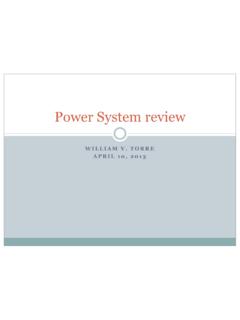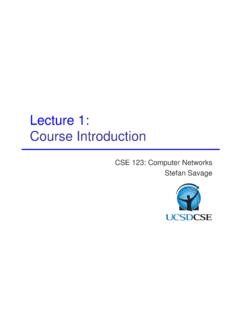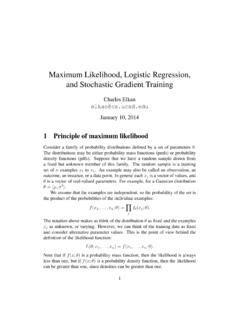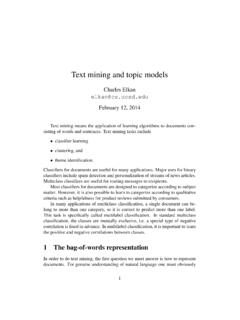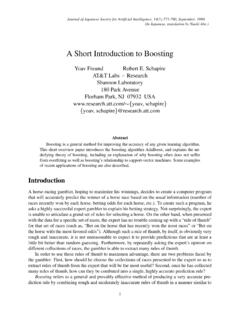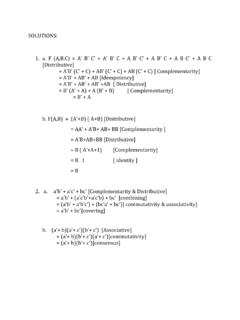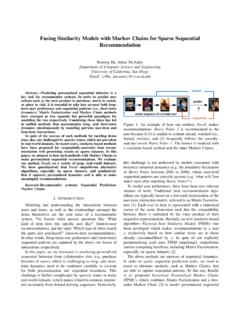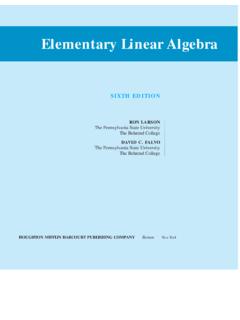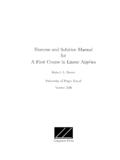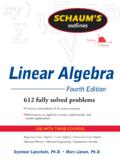Transcription of Linear Equations and Matrices - University of …
1 CHAPTER 3. Linear Equations and Matrices In this chapter we introduce Matrices via the theory of simultaneous Linear Equations . This method has the advantage of leading in a natural way to the concept of the reduced row-echelon form of a matrix. In addition, we will for- mulate some of the basic results dealing with the existence and uniqueness of systems of Linear Equations . In Chapter 5 we will arrive at the same matrix algebra from the viewpoint of Linear transformations. SYSTEMS OF Linear Equations . Let a , .. , a , y be elements of a field F, and let x.
2 , x be unknowns (also called variables or indeterminates). Then an equation of the form a x + ~ ~ ~ + a x = y is called a Linear equation in n unknowns (over F). The scalars a are called the coefficients of the unknowns, and y is called the constant term of the equation. A vector (c , .. , c ) Fn is called a solution vector of this equa- tion if and only if a1 c1 + ~ ~ ~ + an cn = y 115. 116 Linear Equations AND Matrices . in which case we say that (c , .. , c ) satisfies the equation. The set of all such solutions is called the solution set (or the general solution).
3 Now consider the following system of m Linear Equations in n unknowns: a11 x1 +!+ a1n xn = y1. a21 x1 +!+ a2n xn = y2. !!!!"!!!!!!!!!!!!!!!!!"!!!!!!!". am1 x1 +!+ amn xn = ym We abbreviate this system by n ! aij x j = yi ,!!!!!!!!!!!!i = 1,! !,!m!!. j=1. If we let Si denote the solution set of the equation a x = y for each i, then the solution set S of the system is given by the intersection S = S . In other words, if (c , .. , c ) Fn is a solution of the system of Equations , then it is a solution of each of the m Equations in the system. Example Consider this system of two Equations in three unknowns over the real field : 2x1 !
4 3x2 +!!!x3 = 6. !!x1 + 5x2 ! 2x3 = 12. The vector (3, 1, 3) 3 is not a solution of this system because 2(3) - 3(1) + 3 = 6. while 3 + 5(1) - 2(3) = 2 12 . However, the vector (5, 1, -1) 3 is a solution since 2(5) - 3(1) + (-1) = 6. and 5 + 5(1) - 2(-1) = 12 .. Associated with a system of Linear Equations are two rectangular arrays of elements of F that turn out to be of great theoretical as well as practical significance. For the system a x = y , we define the matrix of coefficients A as the array SYSTEMS OF Linear Equations 117. ! a11 a12 ! a1n $.
5 # &. # a21 a22 ! a2n &. A=. # " " " &. # &. " am1 am2 ! amn %. and the augmented matrix as the array aug A given by ! a11 a12 ! a1n y1 $. # &. a a22 ! a2n y2 &. aug!A = # 21 !!. # " " " "&. # &. " am1 am2 ! amn yn %. In general, we will use the term matrix to denote any array such as the array A shown above. This matrix has m rows and n columns, and hence is referred to as an m x n matrix, or a matrix of size m x n. By convention, an element a F of A is labeled with the first index referring to the row and the second index referring to the column.
6 The scalar a is usually called the i, jth entry (or element) of the matrix A. We will frequently denote the matrix A. by the symbol (a ). Another rather general way to define a matrix is as a mapping from a sub- set of all ordered pairs of positive integers into the field F. In other words, we define the mapping A by A(i, j) = a for every 1 i m and 1 j n. In this sense, a matrix is actually a mapping, and the m x n array written above is just a representation of this mapping. Before proceeding with the general theory, let us give a specific example demonstrating how to solve a system of Linear Equations .
7 Example Let us attempt to solve the following system of Linear equa- tions: 2x1 +!!x2 ! 2x3 = !3. !!x1 ! 3x2 +!!x3 =!!!8. 4x1 !!!x2 ! 2x3 =!!3. That our approach is valid in general will be proved in our first theorem below. Multiply the first equation by 1/2 to get the coefficient of x equal to 1: 118 Linear Equations AND Matrices . !!x1 +!!(1 / 2)x2 !!!!x3 = !3 / 2. !!x1 !!!!!!!!!!3x2 +!!!x3 =!!!!!!!8. 4x1 !!!!!!!!!!!!x2 ! 2x3 =!!!!!!!3. Multiply the first equation by -1 and add it to the second to obtain a new sec- ond equation, then multiply the first by -4 and add it to the third to obtain a new third equation: x1 +!
8 !(1 / 2)x2 !!!x3 = !3 / 2. !!!!!!(7 / 2)x2 + 2x3 =!19 / 2. !!!!!!!!!!!!!!3x2 ! 2x3 =!!!!!!!9. Multiply the second by -2/7 to get the coefficient of x equal to 1, then mul- tiply this new second equation by 3 and add to the third: x1 +!!(1 / 2)x2 !!!!!!!!!!!x3 =!!!!3 / 2. !!!!!!!!!!!!!!!!!x2 ! (4 / 7)x3 =!!19 / 7. !!!!!!!!!!!!!!!!!!!!!!!!!(2 / 7)x3 =!!!!6 / 7. Multiply the third by 7/2, then add 4/7 times this new equation to the second: x1 +!!(1 / 2)x2 ! x3 =!!3 / 2. !!!!!!!!!!!!!!!!!x2 !!!!!!!!=!!!!!!1. !!!!!!!!!!!!!!!!!!!!!!!!!x3 =!!!!!!3. Add the third equation to the first, then add -1/2 times the second equation to the new first to obtain x1 =!
9 !2. x2 = !1. x3 =!!3. This is now a solution of our system of Equations . While this system could have been solved in a more direct manner, we wanted to illustrate the system- atic approach that will be needed below.. Two systems of Linear Equations are said to be equivalent if they have equal solution sets. That each successive system of Equations in Example is indeed equivalent to the previous system is guaranteed by the following theorem. Theorem The system of two Equations in n unknowns over a field F. SYSTEMS OF Linear Equations 119. a11 x1 + a12 x2 +!
10 + a1n xn = b1. (1). a21 x1 + a22 x2 +!+ a2n xn = b2. with a 0 is equivalent to the system a11 x1 + a12 x2 +!+ a1n xn = b1. (2). a22. ! x2 +!+ a2n ! xn = b2! in which a 2i = a21 a1i - a11 a2i for each i = 1, .. , n and b 2 = a21 b1 - a11 b2 . Proof Let us define n Li = ! aij x j j=1. so that (1) may be written as the system L1 = b1. (1 ). L2 = b2. while (2) is just L1 = b1. (2 ). a21 L1 ! a11 L2 = a21b1 ! a11b2. If (x , .. , xn) Fn is a solution of (1 ), then the two Equations a21 L1 = a21b1. a11 L2 = a11b2. and hence also a L - a L = a b - a b . are all true Equations .
